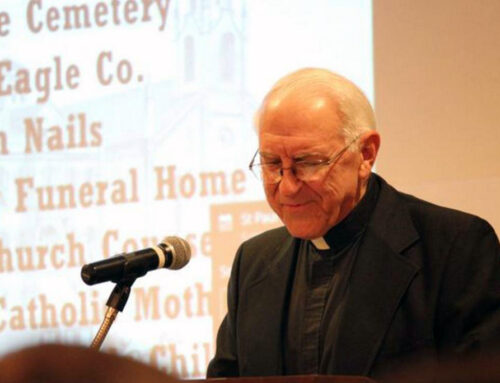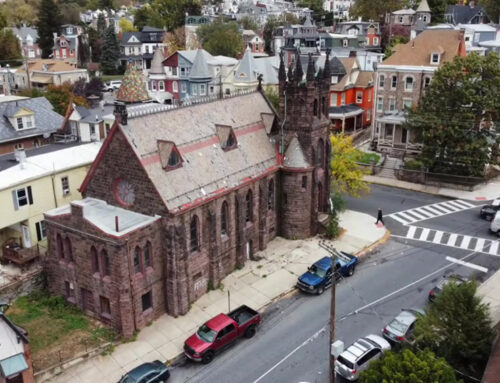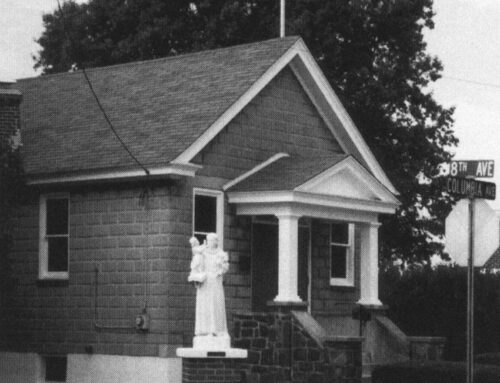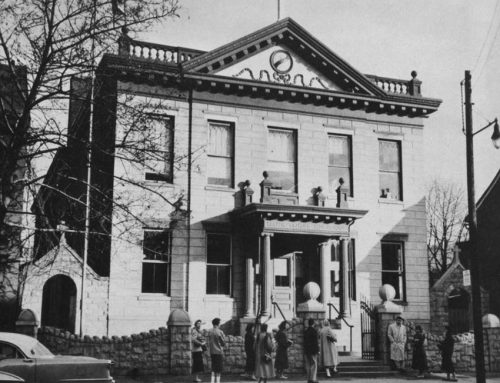Reading was founded in 1748 by Thomas and Richard Penn (sons of William Penn). In 1752 a modest chapel was built on the east side of Duke Street (lot number 321), now Seventh Street, between Franklin and Chestnut Streets, just opposite the site of the old Franklin Street Railroad Station owned by the Reading Railroad.
Below: Location of first Catholic Church and Cemetery in the City of Reading (lot 321 and 320).

That there was a chapel already erected in 1756 is evinced by the will of Peter Bingaman, recorded amongst Berks County records, in which Mr. Bingaman devises to his son-ln-law, John Adam Horner:
“my house in Reading, opposite the Roman Catholic Church.”
Father de Ritter from the mission-centre in Goshenhoppen in 1766 speaks of “a chapel, along-side which was the graveyard, was a little block house on the east side of Duke (now South Seventh ) Street between Franklin and Chestnut Streets. “The first baptismal record is of Margaret Miller, baptized July 14, 1765, by Father de Ritter. The first death record is that of Anna Maria Chaumont, “buried in Catholic graveyard. Reading, November 11, 1765.” A year later on May 11, 1766 he baptized “a child of Lewtis and Felicitas, married slaves of Judge Jonas Seeli (Jonas Seety).
In Sammy Weiser’s list of lot holders, made in 1770, lot number 321, as well as lots 319 and 320 are mentioned as having been “selected by Mr. Snyder for the Catholic Church.” In the first directory of Reading, compiled by M. S. Richards in 1806 this location Is confirmed. The “Mr. Snyder” referred to is Father Theodore Schneider.
Below: Rare view of South 7th Street on the east side, between Franklin and Chestnut, as it appeared possibly in the late 1850s. The arrow points to a lengthy picket fence behind which had been Reading’s first Catholic Church and cemetery.

The chapel, alongside which was the graveyard, was a little blockhouse. About 1790 this was demolished and a small brick church erected in its stead. The first chapel of log construction. was supplanted about 1790 by a brick edifice which was described by a traveler who passed through Reading, at the beginning of the nineteenth century, as:
” A neat, small edifice surmounted with a vane and possessing a fine painting of the crucifixion.”
The “Readinger Zeitung,” (a German paper) on August 10, 1791, stated in way of an advertisement to be paid for:
The honored public is hereby Informed that the corner-stone of the new Catholic Church in Reading will, according to Christian custom, be laid with due solemnity on the 17th day of August next. Friends and well-wishers who desire to witness same are invited to attend.
The church was incorporated under the title of “The Trustees and Members of St. Peter’s Church in the Borough of Reading,” on April 30, 1818, Deed Book No. 29, p. 417. The trustees were: Sebastian Allgaier, J. G. Repplier, Joseph Obold, and Jacob Lamtbert. The membership was as follows: Jonathan Allgaier, William Rehr, William Fricker, Chestner Rittner, .Jr., Jacob Hartman, Daniel Clay, John Hartman, John Kunz, Michael Hartman, Jacob Felix, Simon Seyfert, George Siegfried, Jacob Allgaier, and Joseph Lambert.
The members of the original congregation were Germans; some of these were of mixed French ancestry, having come from Alsace and Lorraine. In addition to those who served this Church from the mission centre at Goshenhoppen, the following were also rectors of Saint Peter’s prior to 1860: Rev. Fathers Schoenfelder, Sharp, Lempke, Cobbin, Carbon, Helbron, Schorb, and Kuenzer. Best of all was the Rev. Augustine Bally, S.J., in a recognition of whose worth and labors the villiage of Goshenhoppen changed its name after his death, to Bally, as it is now known.
The church of Reading was not a regular charge of Father Bally, however on account of the scarcity of priests, then experienced throughout the entire country, it sometimes happened that the pastorate of Reading was vacant. At these times Father Bally was called upon and always responded with the greatest good will, constantly making the journey on horseback.
The iron industry had early development in Berks County. During the eighteenth century it steadily grew in importance; and in 1835 the extensive Reading Iron Works were established. This together with the building of canals, drew here a large number of Irish settlers, and English speaking priests began to appear.
In May, 1836, the church having become inadequate for the worshippers, a committee was appointed to consider ways and means of enlarging it. Little was done in the matter until 1844. About this time the Reading Railroad was built locating their depot and workshop opposite the little Catholic Church on South Seventh Street. This for a short time did not interfere, but soon became apparent that the increasing business of the railroad acted injuriously on the church. On account of the incessant noise divine service could not be performed with that silence and solemnity which is dear to all good Catholics. The church and graveyard on South Seventh Street were sold in 1845, to Jacob Miller for $3,000.
In 1886 an old lady who had known the first primitive chapel was called upon to embody her recollections in a written description but she was so distressed by the disturbance to divine service caused by the railroad tracks recently Iaid upon the fastidious thoroughfare of Seventh Street that she would talk of little else and the opportunity to secure some valuable data concerning the early Roman Catholic Church in Reading was lost forever.
With the approbation of the bishop it was determined to purchase the property on South Fifth Street, where the present Saint Peter’s Church now stands. The cemetery adjoining the old church, at 111 Duke Street (now known as 7th Street) was relocated to a new burial place at the foot of the Neversink Mountain otherwise known as Nanny Goat Hill Cemetery. The bodies which had been buried in the old cemetery were transferred to their new resting place.






Leave A Comment